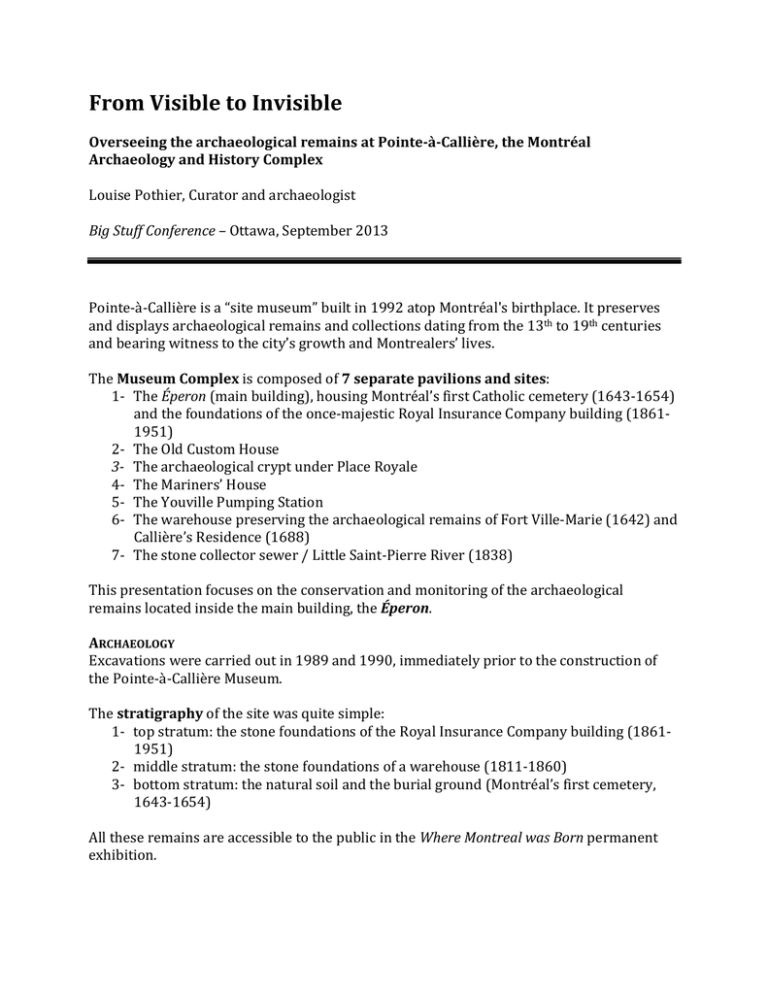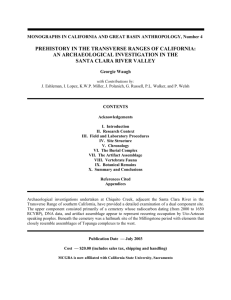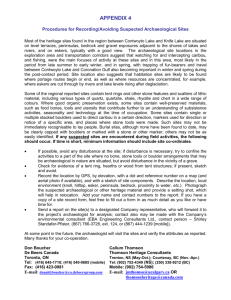From Visible to Invisible
advertisement

From Visible to Invisible Overseeing the archaeological remains at Pointe­à­Callière, the Montréal Archaeology and History Complex Louise Pothier, Curator and archaeologist Big Stuff Conference – Ottawa, September 2013 Pointe‐à‐Callière is a “site museum” built in 1992 atop Montréal's birthplace. It preserves and displays archaeological remains and collections dating from the 13th to 19th centuries and bearing witness to the city’s growth and Montrealers’ lives. The Museum Complex is composed of 7 separate pavilions and sites: 1‐ The Éperon (main building), housing Montréal’s first Catholic cemetery (1643‐1654) and the foundations of the once‐majestic Royal Insurance Company building (1861‐ 1951) 2‐ The Old Custom House 3­ The archaeological crypt under Place Royale 4‐ The Mariners’ House 5‐ The Youville Pumping Station 6‐ The warehouse preserving the archaeological remains of Fort Ville‐Marie (1642) and Callière’s Residence (1688) 7‐ The stone collector sewer / Little Saint‐Pierre River (1838) This presentation focuses on the conservation and monitoring of the archaeological remains located inside the main building, the Éperon. ARCHAEOLOGY Excavations were carried out in 1989 and 1990, immediately prior to the construction of the Pointe‐à‐Callière Museum. The stratigraphy of the site was quite simple: 1‐ top stratum: the stone foundations of the Royal Insurance Company building (1861‐ 1951) 2‐ middle stratum: the stone foundations of a warehouse (1811‐1860) 3‐ bottom stratum: the natural soil and the burial ground (Montréal’s first cemetery, 1643‐1654) All these remains are accessible to the public in the Where Montreal was Born permanent exhibition. CONSERVATION ISSUES IN THE ÉPERON BUILDING 1­ The cemetery 2­ The Royal Insurance building (RIB) foundations 1­The cemetery The 17th‐century burial ground was a source of significant conservation challenges in the 1990s, owing mainly to salt evaporation with resulting deterioration of the surface soils. The challenge was met by installing a sealing membrane, a delicate operation involving the following steps: moulding and removal of the overlaying surface soil, section by section installation of the membrane putting the surface soil back in place. The results of the operation were conclusive; afterwards, the deterioration stopped completely. 2­ The Royal Insurance building (RIB) foundations The remains of the RIB are composed of stone and brick walls and a stone slab floor. The whole basement level of the building has been preserved and now forms part of the permanent exhibition. Visitors can walk through the remains, stepping on the original floor. Over the years, the site accumulated a series of structural problems, indicating changes in the soils below the surface. Nature of the problems broken coping stones cracking of some joints, mainly around the burial ground settling of the 19th‐century masonry Starting in 1998, some of these problems became visible. The gaps were filled and the cracks sealed. The site was cleaned and maintained twice a year and observed changes to the remains were recorded in a logbook. But because we had no precise survey records to serve as reference tools, it was difficult to assess the extent of the settling. We kept track of the situation manually, noting and recording the dimensions of the cracks or damage and photographing them. Understanding the sources of the problems We had to survey the subsoil around the damaged area to understand the origin and causes of the problem. The initial archaeological stratigraphy gave us some clues: the 19th‐century stone walls and floor rest on layers of clay wooden planks and beams were also used as foundations beneath and behind the layers of clay Methodology used for identifying and locating the sources of the problems: 1. 3D laser scans of the site over the long term to detect structural movement 2. drilling test holes near critical areas 3. analyzing the moisture/plasticity of the clay and the composition of understructures In 2009, an initial 3D laser digital survey of the entire site was conducted. Five permanent control points were set up. These georeferenced control points allowed us to link up the different scans and provided us with hitherto impossibly precise surveys of the entire site. The following year, a second series of scans was conducted and by comparing the data we were able to visualize the changes that had occurred over the previous twelve months – in this case, settling of the stone slab floor and deformation of a soil retaining wall. The data were displayed in the form of colours superimposed on the survey plan. Although these changes were imperceptible to the naked eye, the survey allowed us to identify at‐risk areas and plan underpinning work as part of an overall preventive maintenance program for the site. These surveys have been conducted annually since then. In 2010, a geotechnic survey with 2 drilling test holes and 3 manual surveys were performed by archaeologists and engineers in two areas, near the cemetery and in the multimedia room. The holes were 2.43 m and 3.66 m deep. Moisture and plasticity analysis of the clay revealed normal natural water content, and the plasticity grade was also good. However, a wooden beam serving as a base for a foundation wall was located and found to be completely rotten, thus affecting the stability of the structure. It was identified as the probable main cause of the settling of the walls. Restoration and stabilizing program for the site The foundations will be stabilized over the coming months, under the supervision of engineers. The solutions include: Removing the rotten wood under the stone walls Replacing the wood by injecting a mixture of urethane or, depending on the situation, a mixture of concrete. The different methods still need to be tested before they are used more extensively under the fragile or damaged areas. And since the factors influencing changes on the site are continually evolving, 3D scans and visual observations are the best methods to help us identify the areas where underpinning work will need to be done.


